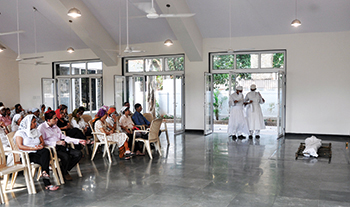The consignment dilemma
Berjis Desai
After a great deal of reluctance, our 92-year-old mother has opted for the Prayer Hall at Worli. Ever since this facility was inaugurated, the number of Parsis opting to be cremated is accelerating. All
post death religious rituals and ceremonies, as at Doongerwadi, are performed in this Hall, a substitute for the ‘Cremate-ni-
bungli,’ made possible with the active involvement of Dinshaw Tamboly who is chairman of The Prayer Hall Trust (TPHT); former Bombay municipal commissioner
Jamsheed Kanga; erstwhile managing director of Glaxo Burroughs Wellcome Homi Khusrokhan; and a munificent donation of Rs 1.5 crores from the A. H. Wadia Trust. Nearly a dozen priests are now available at this new Prayer Hall whose environs are clean and pleasant. A stone’s throw away is the public electric crematorium. The process is speedy and seamless.
On the other hand, the Towers are still faulty. The solar panels, though operated at high intensity, are not functioning optimally. During the monsoon months of June to September, the panels are terribly dysfunctional. Across the road, residents of
Spenta complain of
stench. Disposal is still grisly, gory and gruesome. The crusading zeal of Dhun Baria, who exposed the state of affairs at Doongerwadi a decade ago, is dimmed by age and frustration. Other reform initiatives have also lost steam. Many have watched the
gut wrenching video recordings of the horrors inside the
dakhmas. Unworkable plans like building a vulture aviary have been shelved. There is an almost universal conspiracy to remain silent lest this priceless property is lost to any unholy nexus between politicians and builders.
Despite the gnawing discomfort of knowing that the bodies of those consigned are often recognizable for months thereafter (particularly, during the monsoon months); and despite the availability of this new Prayer Hall, why do most Parsis still prefer the Towers? Maybe, a man likes to exit in the same manner as his forefathers. And the Towers do have many endearing features.
Parsipanu can be seen and felt in the environs of the
bunglis. Time, literally, stands still. The collective vibrations of the thousands of
geh
sarnas,
uthamnas and
saroshes, intoned during the last few centuries, can still be felt by the sensitive. An aura of protection exists from the occult circuits in the ground, created throughout Doongerwadi. As soon as the Doongerwadi hearse winds its way uphill to the
bunglis, within
seconds one is transported from the cosmopolitan traffic jams of Kemps Corner into an exclusive oasis of silence.

A
geh
sarna in progress at the Prayer Hall
The pall bearers bathe the body and call you to tie the
kusti, for the last time,
round the body. A priest gently mumbles prayers before the body lying in rest as the sandalwood and incense laden breeze wafts through. You quietly reflect upon the life of your loved one which has just ended, as countless Parsis before you have done, exactly at the same spot and exactly in the same manner. This is indeed so cathartic. Throughout the night, the pin drop silence is punctuated by a solitary dog barking.
So is the ritual of the mourners walking in pairs,
limply clutching a white handkerchief; the face of the deceased being exposed for a final goodbye on a marble platform just outside the
dakhmas; the mourners silently waiting for the pall bearer to clap thrice to signify that the body has been consigned; the recitation of the short prayers to the
dakhmas followed by a cleansing
kusti; offering a sandalwood stick to the
dadgah fire; and then quietly making your way downhill to the
bungli, when you may spot a dancing peacock. All this simply cannot be replicated.
Of course, if you are a dispassionate stoic, you may dismiss all this as sentimental claptrap and argue that the central purpose — disposing the dead — is not being achieved; and hence, the new Prayer Hall is the only option. However, for most, handling death delicately is very important.
Strangely, this dilemma can be resolved with ease. The optimal solution is to have an electric crematorium at the Towers. At first blush, this may appear radical. However, in the months when the solar panels work (and we are reliably told that they are operated now at considerable intensity), the body is dehydrated, with wisps of smoke emanating, within 48 to 72 hours. This is nothing but a solar powered crematorium. Technology is now available in India to set up a solar powered crematorium which can work on stored solar power, and thereby, even during the monsoon months. If a referendum is conducted on this issue, we believe that the community will overwhelmingly support the proposition. The present trustees of the Bombay Parsi Punchayet do have the resolve to make this move. Better than sitting on a time bomb of a public health scandal, which is too unpleasant even to imagine.
If this proposal is implemented, the traditional way can be seamlessly merged with
state of the art technology. The sun will continue to remain as the energy which
disposes, exactly as the scriptures dictate. The
post death soothing will not be denied to anyone. Perhaps, TPHT will then be too happy to dedicate the premises to our sister communities.
Berjis M. Desai,
senior partner of J. Sagar Associates, advocates and solicitors, is a writer and community activist.
